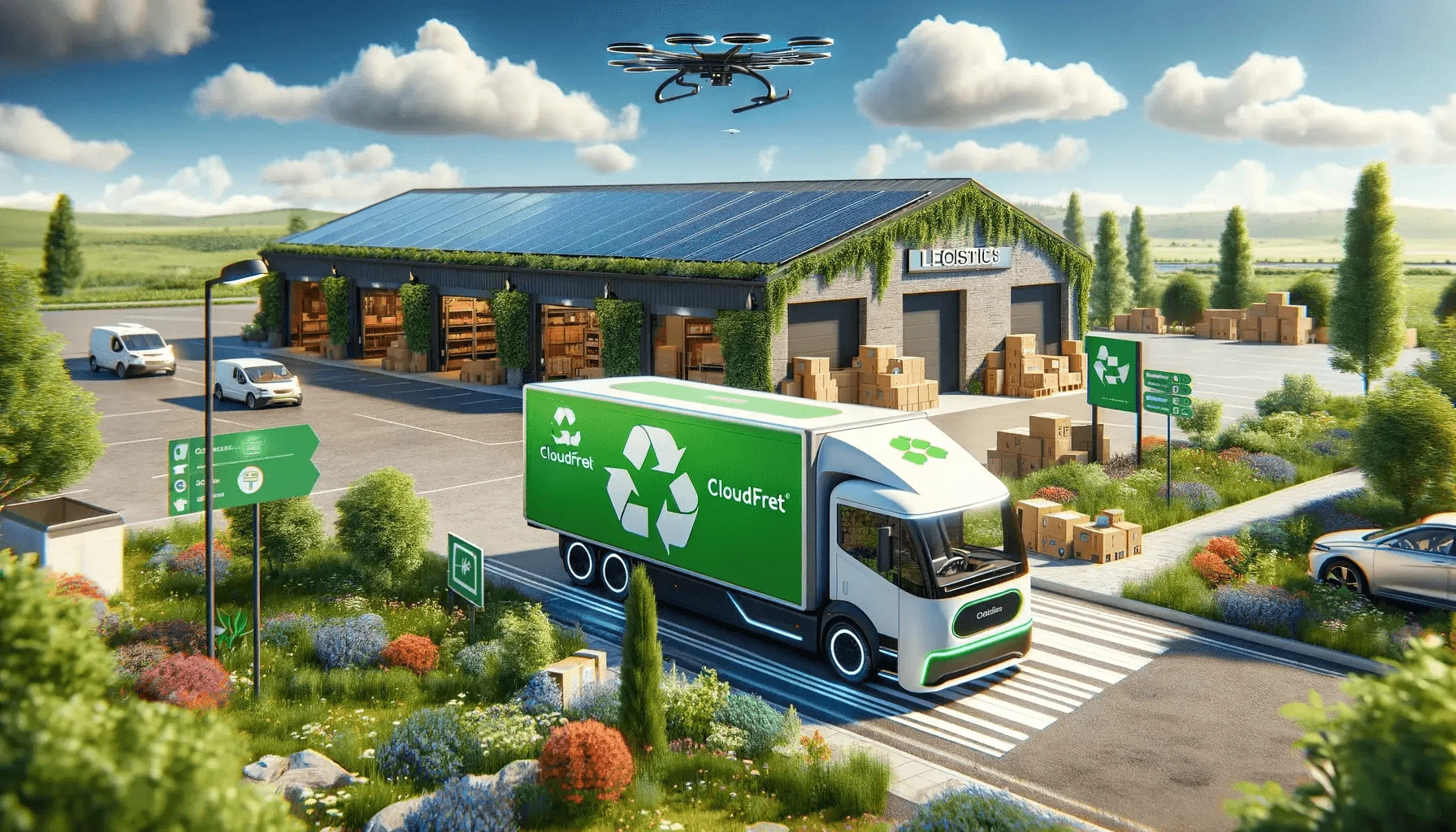Key takeaways
- E-commerce shows itself to be a potent ally in promoting environmentally friendly transportation solutions and lowering carbon emissions in a world where sustainable mobility is becoming more and more important.
- E-commerce platforms have the power to transform the way we buy and do business.
- They can inform customers about eco-friendly transportation options, streamline delivery routes, and switch to electric vehicle fleets for environmentally responsible deliveries.
- Companies like Amazon, Shopify, and Instacart are leading the way in the e-commerce sector to promote sustainability and have a good environmental effect through creative initiatives and smart collaborations.
- We can create more habitable and sustainable communities while preserving our world for future generations by adopting these eco-friendly activities.

Introduction
There has never been a more important time for e-commerce to support environmentally friendly transportation solutions as the world moves toward a more sustainable future. E-commerce sites such as Amazon, Shopify, and Instacart are at the forefront of bringing about good change in the way we shop and do business. These businesses are establishing a standard for the industry to emphasize sustainability by converting to electric vehicle fleets, streamlining delivery routes, and educating customers about sustainable mobility options. With the help of creative projects and smart alliances, e-commerce is now about more than simply convenience; it’s about actually improving the environment and setting the stage for a more sustainable future.
The Importance of Sustainable Mobility
The use of transportation choices that minimize adverse effects on the environment while satisfying the requirements of people and communities is referred to as sustainable mobility. It entails supporting energy-efficient transportation options that cut greenhouse gas emissions and put the health of people and the environment first.
Adopting sustainable mobility methods can help us solve the urgent problems of air pollution, transportation congestion, and climate change. In addition to lowering carbon emissions, sustainable transportation solutions also promote public health, minimize noise pollution, and improve air quality.
Sustainable mobility is an essential component of accomplishing global sustainability goals, not merely a catchphrase. By giving priority to environmentally friendly modes of transportation, we are not only constructing eco-friendly cities and communities but also making substantial progress in reducing the effects of climate change. In order to create inclusive, resilient cities that can withstand future difficulties, it is essential to make the transition to sustainable mobility. Accepting this change is essential to moving toward a low-carbon economy and ensuring future generations have a brighter future.
The Role of E-commerce in Sustainable Transportation
Electronic commerce, or e-commerce, has completely changed how we shop and do business. It entails purchasing and selling goods and services online, doing away with the need for physical storefronts and the corresponding transportation-related carbon emissions.
E-commerce has the potential to be a major force in promoting environmentally friendly transportation solutions. Because fewer people must make separate excursions to traditional brick-and-mortar businesses when buying online, there are fewer cars on the road and less traffic jams. E-commerce also makes it possible to consolidate items into central warehouses, which optimizes delivery routes and minimizes the distance driven by each truck.
The use of electric vehicles (EVs) for delivery in recent years has improved e-commerce’s sustainability even further. A lot of online retailers are changing their delivery teams. to electric vehicles, which produce zero tailpipe emissions and contribute to cleaner air quality in urban areas.
E-commerce sites also have the ability to inform customers about environmentally friendly transportation choices. E-commerce platforms may encourage people to make more sustainable decisions by, among other things, supporting public transit, offering information on eco-friendly items, and offering incentives for short-distance rides on bicycles or electric scooters.

Benefits of Eco-Friendly Transportation Options
There are many advantages to using environmentally friendly modes of transportation for people, communities, and the environment. Among the main advantages are:
– Decreased carbon emissions: Green transportation choices, such electric cars, bicycles, and public transportation, emit little to no greenhouse gases, which contributes to the fight against climate change.
– Better air quality: Eco-friendly solutions help to improve air quality and lessen health risks associated to pollution by encouraging greener forms of transportation and lowering reliance on fossil fuels.
– Financial savings: Using a sustainable transportation method can help people save money on parking, gasoline, and auto maintenance.
– Decreased traffic congestion: Eco-friendly solutions contribute to a reduction in traffic congestion, resulting in shorter commute times and more efficient traffic flow, by promoting the use of public transportation and alternative forms of transportation.
– Health benefits: Physical exercise from active means of transportation, such as walking or cycling, promotes people’s health and well-being.
We can build more livable, sustainable communities and save the environment for coming generations by adopting eco-friendly transportation solutions.
Challenges and Solutions in Promoting Sustainable Mobility
While encouraging sustainable mobility is important, there are obstacles involved. Among the principal difficulties are:
– Lack of infrastructure: The adoption of sustainable mobility alternatives may be hampered by a lack of infrastructure for alternate means of transportation, such as bike lanes, pedestrian-friendly walkways, and electric car charging stations.
– Limited accessibility: People may find it challenging to select sustainable solutions in some places due to limited access to public transit or other forms of alternative mobility.
– Resistance to change: People frequently exhibit resistance to change, making them wary of converting from their conventional forms of transportation to more environmentally friendly options.
A number of strategies may be put into practice to get over these obstacles and encourage sustained mobility:
– Infrastructure development: Building bike lanes, pedestrian-friendly walkways, and electric car charging stations are just a few examples of the infrastructure that governments and municipal planners can invest in to assist sustainable mobility.
– Public awareness campaigns: Creating knowledge of the advantages of sustainable transportation choices as well as the negative effects that traditional forms of transportation have on the environment and human health can help to modify people’s behavior.
– Governments and organizations can offer financial aid and incentives to encourage the purchase of bicycles, electric cars, and other environmentally friendly modes of transportation in order to lower their cost and increase accessibility.
– Partnerships and collaboration: In order to develop sustainable mobility solutions, corporations, government agencies, and community organizations must work together. Stakeholders may successfully address transportation concerns by pooling resources and expertise via collaborative efforts.
Case Studies: Successful E-commerce Strategies for Eco-Friendly Transportation
Numerous online retailers have effectively included tactics to encourage environmentally conscious modes of transportation. Below are a few noteworthy case studies:
– Amazon: One of the biggest online retailers in the world, Amazon has worked hard to lessen its carbon impact. By 2030, the firm hopes to have a fleet that is entirely electric thanks to investments made in electric delivery vehicles. Furthermore, Amazon has instituted packaging programs aimed at reducing waste and maximizing delivery effectiveness.
– Shopify: This well-known e-commerce platform offers its merchants alternatives for carbon offsets by collaborating with a number of shipping companies. This encourages sustainability in the e-commerce sector by enabling companies using Shopify to offset the carbon emissions related to transporting their goods.
– Instacart: To introduce an electric delivery fleet in certain locations, the well-known online grocery delivery service Instacart has teamed up with Nissan, a producer of electric vehicles. This program attempts to encourage environmentally friendly modes of transportation and lower emissions from supermarket delivery services.
These case studies show that by integrating environmentally friendly practices into their operations and delivery procedures, e-commerce businesses may have a major influence on sustainable transportation.
Conclusion
In conclusion, cleaner transportation and e-commerce are combining to create a more sustainable future. Delivery routes are being streamlined, electric vehicle fleets are being given priority, and consumers are being made aware of sustainable transportation choices by e-commerce behemoths like Amazon, Shopify, and Instacart. These businesses are changing the industry norm and demonstrating to the rest of the world that sustainability and convenience can coexist by adopting eco-friendly methods. We are not just lowering carbon emissions and enhancing air quality as we emphasize sustainable transportation, but we are also building more resilient and livable communities for future generations. In the future, e-commerce will focus more on improving the environment than it will on turning a profit. and shaping a more sustainable tomorrow.

FAQ
What is sustainable transport and mobility?
The adoption of transportation strategies that satisfy the demands of people and communities while having as little detrimental effect on the environment as possible is referred to as sustainable transport and mobility. It includes a variety of environmentally friendly ways to get around, such biking, walking, public transportation, carpooling, and electric cars. Its goals are to lower carbon emissions, enhance air quality, and advance the welfare of both people and the environment. We can solve urgent problems like air pollution, traffic congestion, and climate change by giving priority to sustainable transportation solutions. We can also work to build more inclusive, resilient, and livable communities. Sustainable transportation involves making deliberate decisions that benefit both the current and future generations, not merely getting from point A to point B.
What are sustainable transportation options?
Eco-friendly travel solutions that minimize environmental damage and enhance the welfare of persons and communities are referred to as sustainable transportation options. Walking, bicycling, public transportation, carpooling, and electric cars are a few important sustainable transportation choices. These forms of transportation encourage physical activity, lessen traffic congestion, emit little or no emissions, and enhance air quality. People may save money, improve their health, and increase community livability all while having a beneficial environmental effect by selecting sustainable transportation alternatives. Accepting these environmentally beneficial modes of transportation is essential to building a more resilient and sustainable future for everybody.
How can e commerce improve sustainability?
By encouraging environmentally efficient modes of transportation, e-commerce platforms significantly contribute to sustainability improvements. E-commerce platforms have the potential to bring about good change in the transportation business by working with environmentally aware enterprises, educating customers about sustainable practices, and giving incentives for making green choices. E-commerce firms have the ability to optimize delivery routes, develop carbon offset programs, and collaborate strategically with electric vehicle manufacturers to minimize carbon emissions and foster a more sustainable future. E-commerce platforms are not only satisfying consumer demand for environmentally aware practices but also establishing a standard for a more environmentally friendly and greener sector by making sustainability a top priority in their operations.
What are the pillars of sustainable mobility?
The cornerstones of sustainable mobility are fundamental ideas that serve as the basis for advocating for eco-friendly modes of transportation. These pillars consist of safety, equity, affordability, efficiency, and accessibility.
The availability and usability of sustainable transportation solutions are referred to as accessibility, guaranteeing that people have easy ways to move about without using fossil fuels. By lowering the price of conventional forms of transportation and offering incentives for eco-friendly alternatives, affordability is essential to ensuring that everyone can use eco-friendly transportation. In order to promote better traffic flow and shorter travel times, efficiency focuses on optimizing transportation systems to lower emissions and congestion. Equity highlights how crucial it is to guarantee that everyone, regardless of socioeconomic background or geography, has access to sustainable transportation solutions. As it guarantees people may move in a safe and secure manner whether they are walking, riding, or taking public transportation, safety is an essential pillar.
Communities may develop a more equitable, effective, and ecologically friendly transportation system that benefits people and the environment by giving priority to four pillars of sustainable mobility.
Hope this article was helpful for more check out our previous blog post by clicking here

